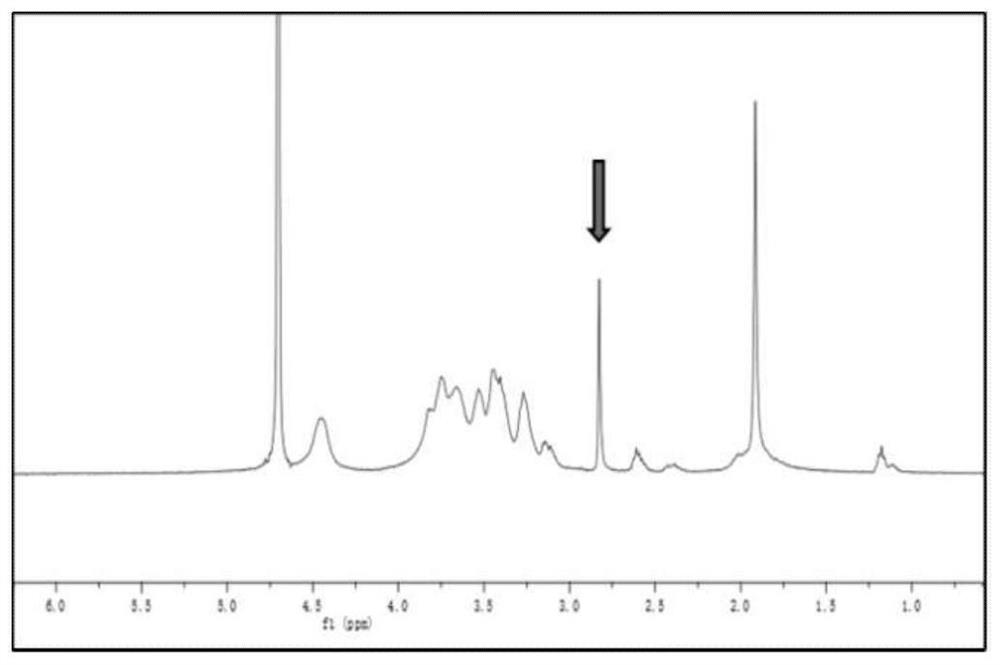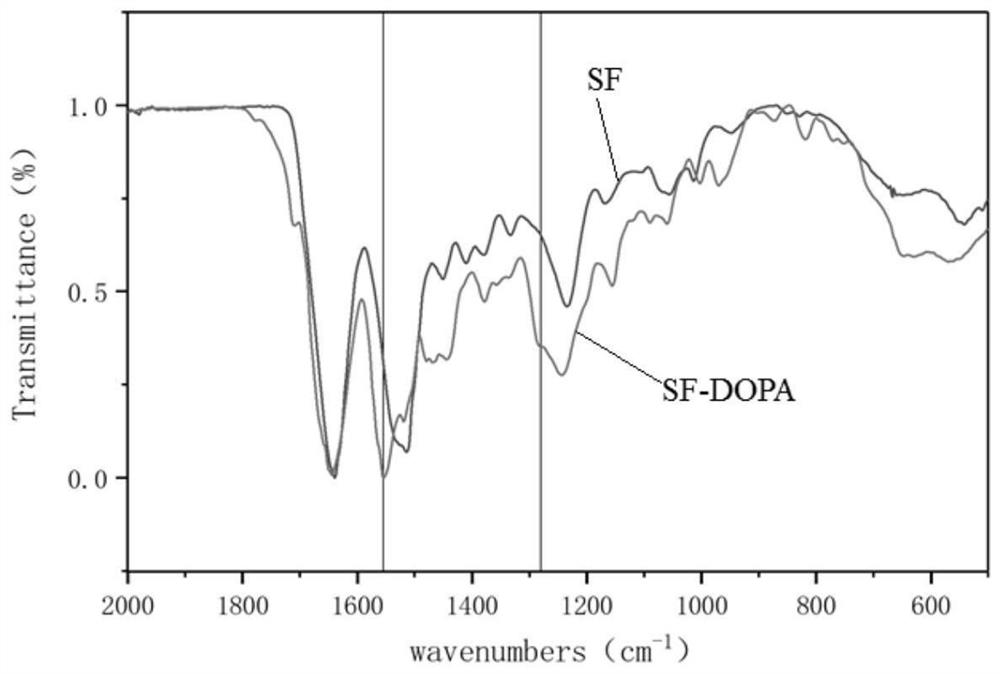A scaffold material capable of recruiting endogenous mesenchymal stem cells and its preparation method and application
A technology of scaffold material and mesenchymal stem cells, which is applied in prosthetics, tissue regeneration, medical science, etc., can solve the problems of low immunogenicity, fast degradation of hyaluronic acid, lack of cell adhesion sites, etc., and achieve mechanical properties and degradation Appropriate performance, conducive to the delivery of nutrients, and beneficial to the effect of maintaining the phenotype of cells
- Summary
- Abstract
- Description
- Claims
- Application Information
AI Technical Summary
Problems solved by technology
Method used
Image
Examples
Embodiment 1
[0054] This example prepares thiolated hyaluronic acid (HA-SH), the steps are as follows:
[0055] (1) Dissolve sodium hyaluronate with a molecular weight of 0.3MDa in deionized water, add N-hydroxysuccinimide (NHS), fully dissolve, and then add 1-ethyl-(3-dimethylaminopropyl ) carbodiimide hydrochloride (EDC HCl), fully dissolved, adjust the pH value of the mixture to 4.75 with 1mol / L NaOH solution and 1mol / L HCl solution, react at room temperature for 2h, and then add cysteine The aqueous solution of ammonia hydrochloride (CSH·HCl) was reacted at room temperature for 24 hours, and then the pH value of the reaction solution was adjusted to 8.5 with 1 mol / L NaOH solution, and dithiothreitol (DTT) solution was added to react at room temperature for 12 hours.
[0056] In this step, the molar ratio of sodium hyaluronate, NHS, EDC·HCl, CSH·HCl and DTT is 1:2:4:4:12.
[0057] (2) Adjust the pH value of the reaction solution obtained in step (1) to 3.0 to 3.5 with 1mol / L HCl soluti...
Embodiment 2
[0060] This embodiment prepares dopamine-modified silk fibroin (SF-DOPA), and the steps are as follows:
[0061] (1) Cut the silkworm cocoon into pieces, and use 0.02mol / L Na in a bath ratio of 1:100 2 CO 3 Boil in the solution for 2h to remove sericin, wash and dry, then immerse in 9.3mol / L LiBr solution and dissolve for 4h, transfer the resulting reaction solution into a dialysis bag, and dialyze for 72h with deionized water to obtain silk fibroin (SF ) solution.
[0062] (2) Add to the SF solution obtained in step (1), add EDC·HCl and NHS, adjust the pH value of the mixture to 4.75 with 1mol / L NaOH solution and 1mol / L HCl solution, activate for 2h, then add hydrochloric acid Dopamine was reacted at room temperature for 10 h, and the obtained reaction liquid was transferred into a dialysis bag, and dialyzed with deionized water for 72 h to obtain an aqueous solution of SF-DOPA.
[0063] In step (2), the molar ratio of SF, NHS, EDC·HCl and dopamine hydrochloride is control...
Embodiment 3
[0067] In this embodiment, the steps of preparing freeze-dried sponge support are as follows:
[0068] (1) Dissolve the HA-SH prepared in Example 1 in deionized water to form a HA-SH solution with a concentration of 1wt.% to 10wt.%; adjust the concentration of the SF-DOPA aqueous solution prepared in Example 2 to SF-DOPA The concentration is 1wt.%~10wt.%, to obtain SF-DOPA solution.
[0069](2) Mix the HA-SH solution and the SF-DOPA solution according to the volume ratio of (1~10):(1~10) under ice bath conditions, and use 0.5mol / L NaOH solution and 0.1mol / L NaOH solution The HCl solution adjusted the pH value to 7.4, injected into the silica gel mold, and stood at 37° C. for 5 minutes to form a composite hydrogel. The composite hydrogel was freeze-dried to obtain a freeze-dried sponge scaffold.
[0070] In this example, by adjusting the concentration and volume ratio in steps (1) and (2), a total of five groups of experiments were carried out, and five kinds of freeze-dried s...
PUM
| Property | Measurement | Unit |
|---|---|---|
| pore size | aaaaa | aaaaa |
| storage modulus | aaaaa | aaaaa |
| storage modulus | aaaaa | aaaaa |
Abstract
Description
Claims
Application Information
 Login to View More
Login to View More - R&D
- Intellectual Property
- Life Sciences
- Materials
- Tech Scout
- Unparalleled Data Quality
- Higher Quality Content
- 60% Fewer Hallucinations
Browse by: Latest US Patents, China's latest patents, Technical Efficacy Thesaurus, Application Domain, Technology Topic, Popular Technical Reports.
© 2025 PatSnap. All rights reserved.Legal|Privacy policy|Modern Slavery Act Transparency Statement|Sitemap|About US| Contact US: help@patsnap.com



